洗衣机使用须知中英文对照
洗衣机英文标示
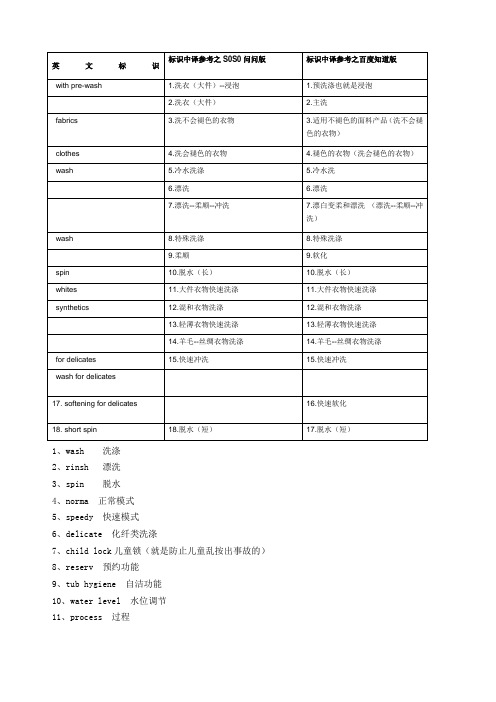
13.轻薄衣物快速洗涤
14.羊毛--丝绸衣物洗涤
14.羊毛--丝绸衣物洗涤
for delicates
15.快速冲洗
15.快速冲洗
wash for delicates
17. softenin spin
18.脱水(短)
17.脱水(短)
烫平机
SET
RUN
FUNC
RUN
FWD
REV
Stop reset 停止复位
Velometer 速度计,调速仪
Tramsducer 变频调速器
Power 功率
5.冷水洗涤
5.冷水洗
6.漂洗
6.漂洗
7.漂洗--柔顺--冲洗
7.漂白变柔和漂洗 (漂洗--柔顺--冲洗)
wash
8.特殊洗涤
8.特殊洗涤
9.柔顺
9.软化
spin
10.脱水(长)
10.脱水(长)
whites
11.大件衣物快速洗涤
11.大件衣物快速洗涤
synthetics
12.混和衣物洗涤
12.混和衣物洗涤
英文标识
标识中译参
1.洗衣(大件)--浸泡
1.预洗涤也就是浸泡
2.洗衣(大件)
2.主洗
fabrics
3.洗不会褪色的衣物
3.适用不褪色的面料产品(洗不会褪色的衣物)
clothes
4.洗会褪色的衣物
4.褪色的衣物(洗会褪色的衣物)
wash
1、wash洗涤2、rinsh漂洗 3、spin脱水4、norma正常模式5、speedy快速模式6、delicate化纤类洗涤7、child lock儿童锁(就是防止儿童乱按出事故的)8、reserv预约功能9、tub hygiene自洁功能10、water level水位调节 11、process过程 12、program程序
洗衣机英文标示
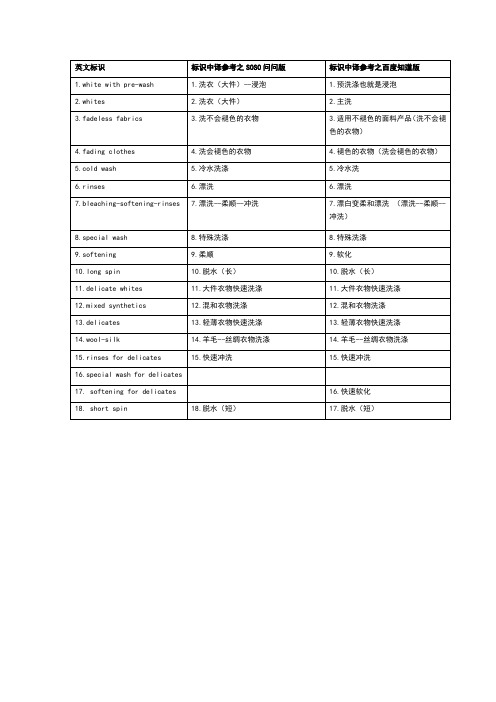
14.羊毛--丝绸衣物洗涤
14.羊毛--丝绸衣物洗涤
15.rinses for delicates
15.快速冲洗
15.快速冲洗
16.special wash for delicates
17. softening for delicates
16.快速软化
18. short spin
18.脱水(短)
17.脱水(短)
1、wash洗涤
2、rinsh漂洗
3、spin脱水
4、norma正常模式
5、speedy快速模式
6、delicate化纤类洗涤
7、child lock儿童锁(就是防止儿童乱按出事故的)
8、reserv预约功能
9、tub hygiene自洁功能
10、water level水位调节
英文标识
标识中译参pre-wash
1.洗衣(大件)--浸泡
1.预洗涤也就是浸泡
2.whites
2.洗衣(大件)
2.主洗
3.fadeless fabrics
3.洗不会褪色的衣物
3.适用不褪色的面料产品(洗不会褪色的衣物)
4.fading clothes
11、process过程
12、program程序
烫平机
SET
RUN
FUNC
RUN
FWD
REV
Stop reset 停止复位
Velometer 速度计,调速仪
Tramsduห้องสมุดไป่ตู้er 变频调速器
Power 功率
4.洗会褪色的衣物
4.褪色的衣物(洗会褪色的衣物)
5.cold wash
5.冷水洗涤
洗衣机指南:首次使用和设置说明书

water.
Adding rinse aid
1. Press the catch on the lid
of the dispenser for rinse
2
aid and lift .
gether and lift
1
the coarse filter
out .
Cleaning spray arms
1. Unscrew the upper spray arm and
2
pull down to remove .
1
2
5. Clean the filter elements under running water.
residue.
2. Turn the coarse filter anticlock-
2
wise and re-
move the filter
system .
1
3. Pull down the micro filter to remove.
4. Press the locking
catches to-
Adding special salt
To avoid damage to the appliance, only add special salt to the dispenser for special salt just before the programme starts. 1. Unscrew the lid of the dispenser for special salt
sharp+es-w110ds+automatic+washing+machine+instruct

Do not place the machine at
high-humidity places such as
bathroom, locations where wind
and rain may get in, and so on.
Otherwise, electric shock, fire,
FORBIDDEN TO USE AT
Stop using the machine
停止使用 此洗衣机
To avoid a fault y or an accident, please pull out the plug from the plug socket. Be sure to entrust the maintenance department to check it, and consult the maintenance department for check and repair fees.
INFLAMMABLES GASOLINE
Before the washing / spin drying
tub completely stops, do not
touch the clothing being washed.
Even if the tub is running at low FORBIDDEN
malfunctions and distortion may
HIGH-HUMIDITY LOCATIONS
take place.
Do not change the original state of power cable. Any artificial damage to the power cable could cause electric shock, electric leakage or other malfunctions.
洗衣机英文标示

2、rinsh漂洗
3、spin脱水
4、norma正常模式
5、speedy快速模式
6、delicate化纤类洗涤
7、child ห้องสมุดไป่ตู้ock儿童锁(就是防止儿童乱按出事故的)
8、reserv预约功能
9、tub hygiene自洁功能
10、water level水位调节
11、process过程
13.轻薄衣物快速洗涤
13.轻薄衣物快速洗涤
14.羊毛--丝绸衣物洗涤
14.羊毛--丝绸衣物洗涤
for delicates
15.快速冲洗
15.快速冲洗
wash for delicates
17. softening for delicates
16.快速软化
18. short spin
18.脱水(短)
17.脱水(短)
wash
5.冷水洗涤
5.冷水洗
6.漂洗
6.漂洗
7.漂洗--柔顺--冲洗
7.漂白变柔和漂洗(漂洗--柔顺--冲洗)
wash
8.特殊洗涤
8.特殊洗涤
9.柔顺
9.软化
spin
10.脱水(长)
10.脱水(长)
whites
11.大件衣物快速洗涤
11.大件衣物快速洗涤
synthetics
12.混和衣物洗涤
12.混和衣物洗涤
12、program程序
烫平机
SET
RUN
FUNC
RUN
FWD
REV
Stop reset停止复位
Velometer速度计,调速仪
Tramsducer变频调速器
Power功率
洗衣机干衣机操作说明书

123456H |+ "drying, iron dry, cupboard dry, fluff/finishedn (Container). (Filter)Empty the condensate container.Clean the fluff filter and/or air cooler under running water a Page 4/6.Emptying condensationEmpty container after each drying operation!1.Pull out condensate container keeping it horizontal.2.Pour out condensation.3.Always push container in fully until it clicks into place.If n (Container) flashes in the display panel a What to do if..., Page 10.Cleaning the fluff filterClean the fluff filter after each drying operation.1.Open the door, remove fluff from door/door area.2.Pull out and fold open the fluff filter.3.Remove the fluff (by wiping the filter with your hand).If the fluff filter is very dirty or blocked, rinse with warm water and dry thoroughly.4.Close and reinsert the fluff filter.Switching off the dryerTurn the programme selector to 0 (Off).Do not leave laundry in the dryer.Removing the laundryThe automatic anti-crease function causes the drum to move at specific intervals, the washing remains loose and fluffy for an hour (two hours if the additional S c (Reduced Ironing) function is also selected-depending on model ).... and adapt to individual requirementsNever start the dryer if it is damaged!Inform your after-sales service.Inspecting thedryer Sorting and loading laundryRemove all items from pockets.Check for cigarette lighters.The drum must be empty prior to loading.See programme overview on page 7.See also separate instructions for “Woollens basket” (depending on model)Your new dryerCongratulations - You have chosen a modern, high-quality Bosch domestic appliance.The condensation dryer is distinguished by its economical energy consumption.Every dryer which leaves our factory is carefully checked to ensure that it functions correctly and is in perfect condition.Should you have any questions, our after-sales service will be pleased to help.Disposal in an environmentally-responsible manner This appliance is labelled in accordance with European Directive 2012/19/EU concerning used electrical and electronic appliances (waste electrical and electronic equipment - WEEE). The guideline determines the framework for the return and recycling of used appliances as applicable throughout the EU.For further information about our products, accessories, spare parts and services, please visit: Intended usePreparing for installation, see Page 8Selecting and adjusting the programmeDryingCondensate container Control panelʋfor domestic use only,ʋonly to be used for drying fabrics that have beenwashed with water.This appliance is intended for use up to a maximum height of 4000 metres above sea level.Keep children younger than 3 years old away from the dryer.Do not let children make the cleaning andmaintenance work on the dryer without supervision.Do not leave children unsupervised near the dryer.Keep pets away from the dryer.The dryer can be operated by children 8 years old and older, by persons with reduced physical, sensory or mental abilities and by persons with insufficient experience or knowledge if they are supervised or have been instructed in its use by a responsible adult.Select the drying programme ...Press the (Start/Stop) button123Make sure your hands are dry. Hold the plug only.Connecting themains plugDryingInformation on laundry ...Labelling of fabricsFollow the manufacturer's care information.(c Drying at normal temperature.'c Drying at low temperature a also select V (Low Heat).)c Do not machine dry.Observe safety instructions without fail a Page 11!Do not tumble-dry the following fabrics for example:–Impermeable fabrics (e.g. rubber-coated fabrics).–Delicate materials (silk or curtains made from synthetic material) a they may crease –Laundry contaminated with oil.Drying tips–To ensure a consistent result, sort the laundry by fabric type and drying programme.–Always dry very small items (e.g. baby socks) together with large items of laundry (e.g. hand towel).–Close zips, hooks and eyelets, and button up covers.Tie fabric belts, apron strings, etc. together–Do not over-dry easy-care laundry a risk of creasing!Allow laundry to finish drying in the air.–Do not dry woolens in the dryer, only use to freshen them up a Page 7, /c Wool finish Programme (depending on model).–Do not iron laundry immediately after drying, fold items up and leave for a while a the remaining moisture will then be distributed evenly.–The drying result depends on the type of water used during washing. a Fine adjustment of the drying result a Page 5/6.–Machine-knitted fabrics (e.g. T-shirts or jerseys) often shrink the first time they are dried a do not use the +: Cupboard Dry plus programme.–Starched laundry is not always suitable for dryers a starch leaves behind a coating that adversely affects the drying operation.–Use the correct dosage of fabric softener as per the manufacturer's instructions when washing the laundry to be dried.–Use the timer programme for small loads a this improves the drying result.Environmental protection / Energy-saving tips–Before drying, spin the laundry thoroughly in the washing machine a the higher the spin speed the shorter the drying time will be (consumes less energy), also spin easy-care laundry.–Put in, but do not exceed, the maximum recommended quantity of laundry a programme overview a Page 7.–Make sure the room is well ventilated during drying.–Do not obstruct or seal up the air inlet.–Keep the air cooler clean a Page 6 “Care and cleaning”.Fine adjustment of the drying resultAdjustment of the levels of dryness1 x to the rightPress and hold V (Low Heat)and turn 5 x to the rightPress V (Low Heat) until the required level is reachedTurn to 0 (Off)Turn to 0 (Off)DrumAll buttons are sensitive and only need to be touched lightly.Only operate the dryer with the fluff filter inserted!Air inletFluff filterDrum interior light (depending on model)Maintenance flapProgramme end once lights up in the display.Interrupt programme removing or adding laundry.The drying cycle can be interrupted for a brief period so that laundry may be added or removed. The programme selected must then be resumed and completed.Never switch the dryer off before the drying process has ended.Drum and door may be hot!1.Open door, the drying process is interrupted.2.Load or remove laundry and close door.3.If required, select a new programme and additional functions.4.Press the (Start /Stop) button.Additional functionsProgramme selectorTime remainingDisplay panelSelect On/Off for a acoustic signal at end of programme.ʋ&(Buzzer)Reduced temperature for delicate fabrics 'that require a longer drying time;e.g. for polyacrylics, polyamide, elastane or acetate.ˎV (Low Heat)Reduces creasing and extends the anti-creasing phase once the program has ended.ˎS c (ReducedIroning)ContentsPageʋPreparation . . . . . . . . . . . . . . . . . . . . . .2ʋSetting the programmes . . . . . . . . . . . . .2ʋDrying . . . . . . . . . . . . . . . . . . . . . . . .3/4ʋInformation on laundry. . . . . . . . . . . . . . 5ʋFine adjustment of the drying result . .5/6ʋCare and cleaning . . . . . . . . . . . . . . . . .6ʋProgramme overview. . . . . . . . . . . . . . . .7ʋInstallation . . . . . . . . . . . . . . . . . . . . . . . .8ʋFrost protection / Transport. . . . . . . . . . .8ʋTechnical data . . . . . . . . . . . . . . . . . . . .9ʋOptional accessories. . . . . . . . . . . . . . . .9ʋWhat to do if... / After-sales service. . . .10ʋSafety instructions . . . . . . . . . . . . . . . .11Read these instructions and the separate Energy-saving mode instructions before operating the dryer.Observe the safety instructions on page 11.ˎh:min End of programme in 1*-24 hours (Press button several times if required)(*depending on the selected programme, e.g. duration 1:54h a 2h. Can always be selected to the next full hour.)Fine adjustment of the drying result The drying result (e.g. Cupboard Dry) can be adjusted over three levels (1 - max. 3) for the L Cottons ,I Easy-Care,L Mix and A Super Quick 40’ programmes a presetting = 0. After one of these programmes has been finely adjusted, the setting is retained for the others. Further information a Page 5/6.0, 1, 2, 3Fine adjustment of the drying resultCare and cleaningDryer housing, control panel, air cooler, moisture sensors–Wipe with a soft, damp cloth.–Do not use harsh cleaning agents and solvents.–Remove detergent and cleaning agent residue immediately.–During drying, water may collect between the door and seal. This does not affect your dryer's functions in any way.Clean the protective filter 5 - 6 times a year or if .(Filter) flashes after cleaning the fluff filter.Air cooler / Protective filterWhen cleaning, only remove the protective filter. Clean the air cooler behind the protective filter once a year.–Allow the dryer to cool.–Residual water may leak out, so place an absorbent towel underneath the maintenance door.1.Unlock the maintenance door.2.Open the maintenance door fully.3.Turn both locking levers towards each another.4.Pull out the protective filter/air cooler.Do not damage the protective filter or air cooler.Clean with warm water only. Do not use any hard or sharp-edged objects.5.Clean the protective filter/air cooler thoroughly,Allow to drip dry.6.Clean the seals.7.Re-insert the protective filter/air cooler,with the handle facing down.8.Turn back both locking levers.9.Close the maintenance door until the lock clicks into place.Moisture sensorsThe dryer is fitted with stainless steel moisture sensors. The sensors measure the level of moisture in the laundry. After a long period of operation, a fine layer of limescale may form on the sensors.1.Open the door and clean the moisture sensors with a damp spongewhich has a rough surface.Do not use steel wool or abrasive materials.L:00, L:01, L:02, L:03 are shown in sequenceShort signal when changing from L:03 to L:00, otherwise long signal.Page 11.Connect to an AC earthed socket. If in doubt have the socket checked by an expert.The mains voltage and the voltage shown on the rating plate (a Page 9) must correspond.The connected load and necessary fuse protection are specified on the rating plate.Note the fuse protection of the socket.Make sure that the air inlet remains unobstructedClean and level press and hold selection then turn 3 x to the rightturn to 0(Off)setamperage off flashes33Do not operate the dryer if there is a danger of frost.en Instruction manualDryerWTE86363SNRemove all items from pockets.Check for cigarette lighters.The drum must be empty prior to loading.See programme overview on page 7.See also separate instructions for “Woollens ba(depending on model)Programme selectorAll buttons areneed to be tou34Emptying condensationEmpty container after each drying operation!1.Pull out condensate container keeping it horizontal.2.Pour out condensation.3.Always push container in fully until it clicks into place.If n (Container) flashes in the display panel a What to do if..., Page 10.Cleaning the fluff filterClean the fluff filter after each drying operation.1.Open the door, remove fluff from door/door area.2.Pull out and fold open the fluff filter.3.Remove the fluff (by wiping the filter with your hand).If the fluff filter is very dirty or blocked, rinse with warm water and dry thoroughly.4.Close and reinsert the fluff filter.Switching off the dryerTurn the programme selector to 0 (Off).Do not leave laundry in the dryer.Removing the laundryThe automatic anti-crease function causes the drum to move at specific intervals, the washing remains loose and fluffy for an hour (two hours if the additional S c (Reduced Ironing) function is also selected-depending on model ).idual requirementsspecting thedryeroading laundryasket”he programmeDryingCondensate container Control paneldrying programme ...(Start/Stop) button123nnecting the mains plugDryingDrume sensitive and only uched lightly.the dryer with nserted!Air inletFluff filterDrum interior light (depending on model)Maintenance flapProgramme end once lights up in the display.Interrupt programme removing or adding laundry.The drying cycle can be interrupted for a brief period so that laundry may be added or removed. The programme selected must then be resumed and completed.Never switch the dryer off before the drying process has ended.Drum and door may be hot!1.Open door, the drying process is interrupted.2.Load or remove laundry and close door.3.If required, select a new programme and additional functions.4.Press the (Start /Stop) button.the g = 0. others.0, 1, 2, 3Information on laundry ...Labelling of fabricsFollow the manufacturer's care information.(c Drying at normal temperature.'c Drying at low temperature a also select V(Low Heat).)c Do not machine dry.Observe safety instructions without fail a Page 11!Do not tumble-dry the following fabrics for example:–Impermeable fabrics (e.g. rubber-coated fabrics).–Delicate materials (silk or curtains made from synthetic material) a they may crease–Laundry contaminated with oil.Drying tips–To ensure a consistent result, sort the laundry by fabric type and drying programme.–Always dry very small items (e.g. baby socks) together with large items of laundry(e.g. hand towel).–Close zips, hooks and eyelets, and button up covers.Tie fabric belts, apron strings, etc. together–Do not over-dry easy-care laundry a risk of creasing!Allow laundry to finish drying in the air.–Do not dry woolens in the dryer, only use to freshen them up a Page 7, /c Wool finishProgramme (depending on model).–Do not iron laundry immediately after drying, fold items up and leave for a while a theremaining moisture will then be distributed evenly.–The drying result depends on the type of water used during washing. a Fine adjustment of the drying result a Page 5/6.–Machine-knitted fabrics (e.g. T-shirts or jerseys) often shrink the first time they are drieda do not use the +: Cupboard Dry plus programme.–Starched laundry is not always suitable for dryers a starch leaves behind a coating that adversely affects the drying operation.–Use the correct dosage of fabric softener as per the manufacturer's instructions whenwashing the laundry to be dried.–Use the timer programme for small loads a this improves the drying result.Environmental protection / Energy-saving tips–Before drying, spin the laundry thoroughly in the washing machine a the higher the spin speed the shorter the drying time will be (consumes less energy), also spin easy-carelaundry.–Put in, but do not exceed, the maximum recommended quantity of laundry a programmeoverview a Page 7.–Make sure the room is well ventilated during drying.–Do not obstruct or seal up the air inlet.–Keep the air cooler clean a Page 6 “Care and cleaning”.Fine adjustment of the drying resultAdjustment of the levels of dryness1 x to the right Press and hold V (Low Heat)and turn 5 x to the rightPress V (Low Heat) untilthe required level is reachedTurn to 0 (Off)Turn to0 (Off)Fine adjustment of the drying resultCare and cleaningDryer housing, control panel, air cooler, moisture sensors–Wipe with a soft, damp cloth.–Do not use harsh cleaning agents and solvents.–Remove detergent and cleaning agent residue immediately.–During drying, water may collect between the door and seal.This does not affect your dryer's functions in any way.Clean the protective filter 5 - 6 times a yearor if .(Filter) flashes after cleaning the fluff filter.Air cooler / Protective filterWhen cleaning, only remove the protective filter. Clean the air coolerbehind the protective filter once a year.–Allow the dryer to cool.–Residual water may leak out, so place an absorbent towelunderneath the maintenance door.1.Unlock the maintenance door.2.Open the maintenance door fully.3.Turn both locking levers towards each another.4.Pull out the protective filter/air cooler.Do not damage the protective filter or air cooler.Clean with warm water only. Do not use any hard or sharp-edgedobjects.5.Clean the protective filter/air cooler thoroughly,Allow to drip dry.6.Clean the seals.7.Re-insert the protective filter/air cooler,with the handle facing down.8.Turn back both locking levers.9.Close the maintenance door until the lock clicks into place.Moisture sensorsThe dryer is fitted with stainless steel moisture sensors. The sensorsmeasure the level of moisture in the laundry. After a long period ofoperation, a fine layer of limescale may form on the sensors.1.Open the door and clean the moisture sensors with a damp spongewhich has a rough surface.Do not use steel wool or abrasive materials.L:00, L:01, L:02, L:03 are shown in sequenceShort signal when changing from L:03 to L:00, otherwise longsignal.56Page 11.Connect to an AC earthed socket. If in doubt have the socket checked by an expert.The mains voltage and the voltage shown on the rating plate (a Page 9) must correspond.The connected load and necessary fuse protection are specified on the rating plate.Note the fuse protection of the socket.Make sure that the air inlet remains unobstructedClean and level press and hold selection then turn 3 x to the rightturn to 0(Off)setamperage off flashes33Do not operate the dryer if there is a danger of frost.en Instruction manualDryerWTE86363SN。
洗衣机中英文对照外文翻译文献
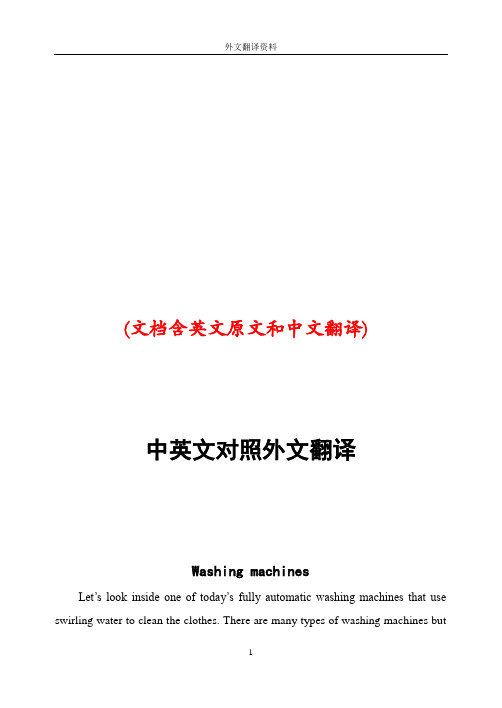
(文档含英文原文和中文翻译)中英文对照外文翻译Washing machinesLet’s look inside one of today’s fully automatic washing machines that use swirling water to clean the clothes. There are many types of washing machines butthis Figure shows you what most of them are basically made up of.。
The reason why a washing machine like this can wash and get the water out of the clothes at the same time is because it has a double layer drum. When washing and rinsing, the pulsator spins and makes the water swirl.. To get the water out of the clothes, the inner wall f the drum spins and the water goes through the holes.These days, the “centrifugal force washing machines” are quite popular. This type of machine does not use a pulsator. Instead, the inner wall spins really quickly. When the drum spins, the dirty clothes get stuck to the wall. The water and detergent also try to escape through the holes of the wall but before they do so, they are forced to escape through the clothes. When this happens, the power of the water and detergent removes the dirt form the clothes. Another good thing about this type of machine is that clothes don’t get tangled up so you don’t have to worry aboutyour clothes getting ripped or damaged.Next, let’s look at some different t ypes of washing machines!Many of you probably think that the water inside washing machines goes round and round. Actually, different washing machines make water flow in different ways.Whirlpool type:This type of washing machine uses a pulsator to force the water to move like a whirlpool inside the Drum. The spinning water forces the dirt out form the clothes inside the machine. Some of the newer models of this type also make the whirlpool move up and down to make it clean clothes even better!Agitator stirring typeThis type of washing machine has something that looks like a propeller at the bottom of the tub. This Propeller spins around and stirs the water. The water then forces the dirt out from the clothes in the machine. The good thing about this type of machine is that clothes do not get tangled up and clothes get evenly washed.Drum type:This type of machine has a drum with many holes in it. There are also protrusions bumps on the wall of the drum. As the drum turns, the clothes are picked up by the protrusions. When the clothes fall down from the top of the drum through the water, the movement removes dirt from the clothes.Centrifugal force type:As we have said before, the spinning drum pushes the water and detergent out through the wall of the inner drum. The power that comes form spinning the drum is called centrifugal force., which is where the name comes from. The water is forced through the clothes and then the holes in the inner wall. After one cycle, the water is recycled back into the tank and the process starts again. This cycle is whatcleans the clothes!In Japan, people first started using machines in 1930. But then the price of a washing machine was so high that most average persons could not buy one for their homes.Looking back now, there was something strange and funny on some of the first versions of the washing machine .The machine had two rollers that were used to sandwich each shirt and other clothes to squeeze the water out of them. The rollers were turned by hand, and in fact, you needed a lot of strength to turn those things! Still, people then thought it was a really neat invention! This type of water squeezer was used for almost 30 years until something new came along. The spin drier that used “centrifugal force” to get most of the water is out of the clothes.In 1953, the nozzle type washing machine was first sold in Japan. This washing machine is like the older brother of the swirling washing machine that you see today. The price of these washing machines was lower and because of this, more people bought them. The first fully automatic washing machine was introduced in 1968, and after that, washing clothes became a lot easier to do!There are a lot of different types of washing machines. What kind of washing machine do you have in your house?Fully automatic:The fully automatic machine has two drum layers that wash, rinse and remove water from clothes together. All you have to do is add detergent and put in dirty clothes and then washing machine will do the rest. There is also a new type of fully automatic washing machine that can dry clothes after they have been washed.Twin tub:This washing machine has one part that dose the washing and another part that does the squeezing. Even though it’s a hassle to t ake the clothes out and move themto other tub, the good thing is that you can wash and squeeze at the same time with one machine.Front loading:The main feature of front loaders is that they use a lot less water than other types. This is the type of Washing machine that dry cleaners use but a lot of people in western countries have this type of washing machine in their homes too.Let’s try to make the best washing machine in the world!We should already thank the scientists that invented the fully automatic washing machine because it makes washing clothes a piece of cake.Scientists are still trying really hard to find ways to make washing machines a lot handier to use for everyone. Some of the things that they are trying to do are to find better ways of making clothes clean and ways to make washing machines last longer. There are washing machines with d trying function today so you don’t even have to hang clothes after words because it dries them automatically! Amazing!Scientists are also trying to find ways to use less water and less detergent in washing machines at present. This is because that it is better to use less water for preserving the environment.What are washing machines of the future going to be like? Maybe there will be a washing machine that dries and folds your clothes after washing them, or maybe there will be one that will wash your clothes while you are still wearing them! How handy would that be! Remember, if the first washing machine was like a dream to people in the old days, all the dreams you have about washing machines of the future may come true!Now, washing machine is becoming more and more popular. We see the main classification.Washing machine can be divided into automatic type and semi-automatic typetwo kinds, automatic type washing machine as long as we begin our work proactively set better washing procedure, washing machine began to work until the end without manual intervention. And semi-automatic washing machine washing and dewatering process is divided, is also called the double barrel washing machine, a tong, one takes off a bucket, and put tong inside washing out to artificial add to take off in the barrel dehydration is handled and complete laundry process.Full-automatic washing machine in structure to take off in tong internal bucket suit, two barrels of axis, while working with the clutch to finish washing state and dehydration of the transition of the states, on the key said is automatic washing machine.Full-automatic washing machine press catharsis means to points, can be divided into bunt washer and roll barrel type two kinds of washing machine, From the electric control ways to points, can be divided into mechanical program-controlled type and computer board controls type washing machine two kinds.The cylinder and the pulsator washing machine are now the main two kinds.Pulsator washing machine working principle is to add clothing, then open the inlet valve, choose good bibcock of water level and correct working procedures, switch on the power, closed warehouse door, and safety switch closed at water level, the public internal switch contacts are and dehydration contacts are interlinked, inlet valve electrify water, when the barrel water reaches the specified height, in air pressure under the action of water level switch inside public contacts disconnect dehydration contacts and connect washing contacts, feed valve power to stop water, motor power is switched on, motor started running, and periodically sometimes are turning, sometimes reverse, mutual alternant, driven by clutch BoLun using the same cycle are turning, inversion, with a certain speed rotating BoLun can drive inside bucket of water and clothing, clothing rotating waterformed in the mutual friction and reach the purpose of laundry. When washing process is completed, drainage electromagnetic valve electrify work, drain valve is opened, inside bucket of water exudes, and linkage shaft also the clutch from washing state switch to dehydration state, when drainage is completed, atmospheric pressure drop and inside bucket of water level switch public contacts reset through dehydration contacts, drainage electromagnetic valve keep electrify state, motor driven off running electrify bucket high-speed and jilt dry clothing, laundry program after washing machine disconnect hydropower and stop. As for intermediate process of how many times, laundry to wash the length of time, by process control.Roller-type washing machine of the principle and Pulsator washing machine are basic similar. But 110mm drum machine it no clutch variable speed, but its motor is double-speed motor, so when washing machine work in washing state, program-controlled device connected motor washing low-speed windings, motor speed slow, working on dehydration, when they connect dehydration modalhigh-speed windings, motor high-speed operation, this process is programmed through the device and motor to work together to finish.To sum up, the role of these two kinds of washing machine is same, but different implementation, each has his strong point, Pulsator washing machine is simulated handmade kneaded action to work, 110mm drum type washing machine is by gravity inertial function to finish our work, they realize washing and dewatering way also have different features, Pulsator washing machine to wear clothes is relatively large, but detergents degree is higher, 110mm drum machine for clothing wear small, but detergents degrees, but lower than Pulsator washing machine to save water.So far, washing machine is still towards a higher requirements development.译文:洗衣机来看一下涡流式全自动洗衣机的构造。
洗衣机英文标示
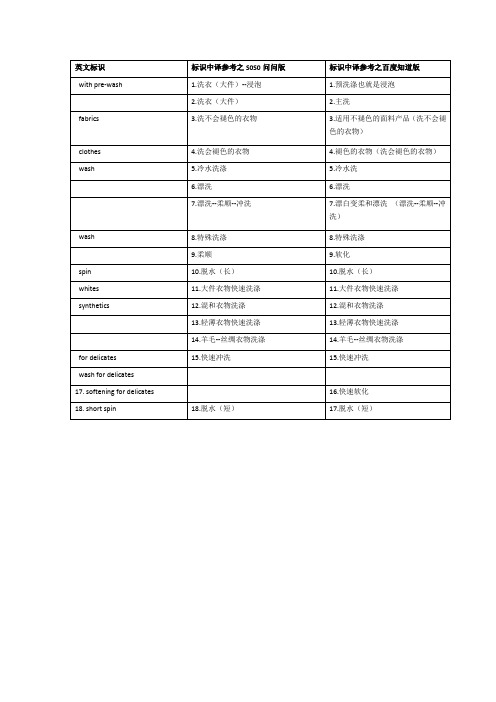
烫平机Βιβλιοθήκη SETRUNFUNC
RUN
FWD
REV
Stop reset 停止复位
Velometer 速度计,调速仪
Tramsducer 变频调速器
Power 功率
英文标识
标识中译参
1.洗衣(大件)--浸泡
1.预洗涤也就是浸泡
2.洗衣(大件)
2.主洗
fabrics
3.洗不会褪色的衣物
3.适用不褪色的面料产品(洗不会褪色的衣物)
clothes
4.洗会褪色的衣物
4.褪色的衣物(洗会褪色的衣物)
wash
5.冷水洗涤
5.冷水洗
6.漂洗
6.漂洗
7.漂洗--柔顺--冲洗
7.漂白变柔和漂洗 (漂洗--柔顺--冲洗)
wash
8.特殊洗涤
8.特殊洗涤
9.柔顺
9.软化
spin
10.脱水(长)
10.脱水(长)
whites
11.大件衣物快速洗涤
11.大件衣物快速洗涤
synthetics
12.混和衣物洗涤
12.混和衣物洗涤
1、wash洗涤
2、rinsh漂洗
3、spin脱水
4、norma正常模式
5、speedy快速模式
6、delicate化纤类洗涤
7、child lock儿童锁(就是防止儿童乱按出事故的)
8、reserv预约功能
9、tub hygiene自洁功能
10、water level水位调节
11、process过程
13.轻薄衣物快速洗涤
13.轻薄衣物快速洗涤
14.羊毛--丝绸衣物洗涤
14.羊毛--丝绸衣物洗涤
西门子IWB 70852 C ECO HK 洗衣机使用说明书
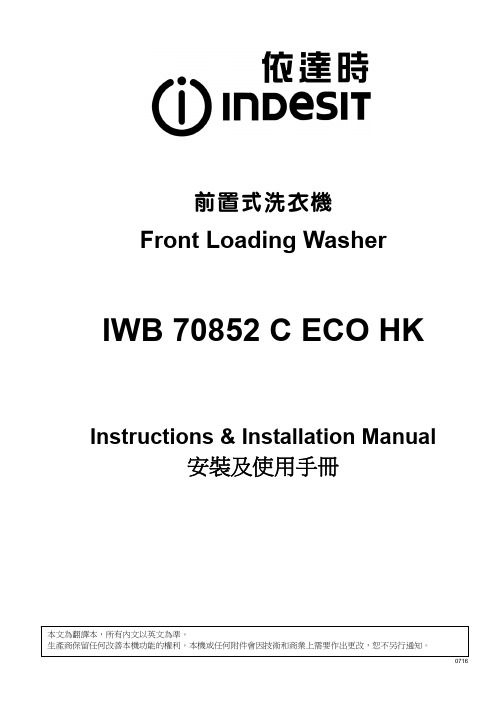
電源連接 Electric connection
將電插頭連接入牆上電源插座前,請作以下檢查︰
Before plugging the appliance into the mains socket, make sure that:
您所使用的插座品質必須符合有關規定。
The socket is earthed and in compliance with the applicable laws. 電源插座必須能夠承受本機數據牌上註明的負荷。 The socket is able to sustain the appliance's maximum power load indicated in the Technical Date Plate fixed on the machine. 電壓必須與本機數據標牌上注意的數值一致。 The power voltage is included within the values indicated on the Technical Date Plate fixed on the machine. 所用插座必須適合本機的插頭,如有需要可更換插座或插頭,但
洗衣机使用须知中英文对照
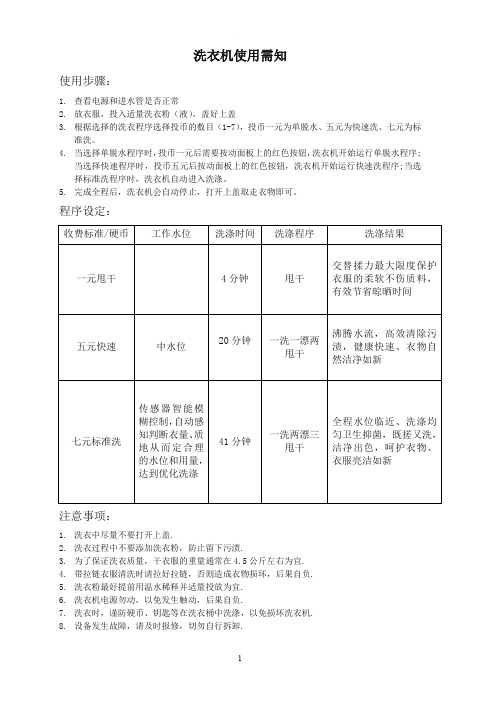
洗衣机使用需知使用步骤:1.查看电源和进水管是否正常2.放衣服,投入适量洗衣粉(液),盖好上盖3.根据选择的洗衣程序选择投币的数目(1-7),投币一元为单脱水、五元为快速洗、七元为标准洗。
4.当选择单脱水程序时,投币一元后需要按动面板上的红色按钮,洗衣机开始运行单脱水程序;当选择快速程序时,投币五元后按动面板上的红色按钮,洗衣机开始运行快速洗程序;当选择标准洗程序时,洗衣机自动进入洗涤。
5.完成全程后,洗衣机会自动停止,打开上盖取走衣物即可。
程序设定:收费标准/硬币工作水位洗涤时间洗涤程序洗涤结果一元甩干4分钟甩干交替揉力最大限度保护衣服的柔软不伤质料,有效节省晾晒时间五元快速中水位20分钟一洗一漂两甩干沸腾水流,高效清除污渍,健康快速、衣物自然洁净如新七元标准洗传感器智能模糊控制,自动感知判断衣量、质地从而定合理的水位和用量,达到优化洗涤41分钟一洗两漂三甩干全程水位临近、洗涤均匀卫生抑菌,既搓又洗,洁净出色,呵护衣物、衣服亮洁如新注意事项:1.洗衣中尽量不要打开上盖.2.洗衣过程中不要添加洗衣粉,防止留下污渍.3.为了保证洗衣质量,干衣服的重量通常在4.5公斤左右为宜.4.带拉链衣服清洗时请拉好拉链,否则造成衣物损坏,后果自负.5.洗衣粉最好提前用温水稀释并适量投放为宜.6.洗衣机电源勿动,以免发生触动,后果自负.7.洗衣时,谨防硬币、钥匙等在洗衣桶中洗涤,以免损坏洗衣机.8.设备发生故障,请及时报修,切勿自行拆卸.Washer instructions for useUse by steps :1.See whether the normal power supply and into the water2.Put clothes into appropriate detergent (liquid), covered roof3.Depending on the chosen number of coin laundry process choice (1-7), a dollar coinas a single dehydration, five dollars for the quick wash, triple the standard wash.4.when choose single dewatering program, pay one dollar to press the red button onthe panel, washing machine start running single dewatering program; When choosing fast programs, after five yuan coin, press the red button on the panel, washing machine start running fast wash program; When choosing standard wash program, washing machine into the washing.5.The completion of the whole, the washing machine will automatically stop, open thecover of clothing can be removedProgram settings:Fees / coins Working levelWashingtimeWashingprocedureWashing resultsOne yuan drying4minutesDryingAlternate maximum protectionclothing rubbing the soft powernot to hurt the material,effectively saving drying timeFiveyuan dual fast mid level20minutesA drift of atwo-dryingwashingBoiling water, remove stainsand efficient, healthy andrapid, clean clothing, such asthe new naturalSevenyuan standard wash Intelligent sensorcontrol, auto-sensejudgments clothingvolume, texture andthe water level to bea reasonable amountto optimize washing41minutesTwo or threedrying of adriftNear full level, even healthantibacterial wash, wash andrub only, clean well, care ofclothing, clean clothes brightas newNotes:1.Do not open the cover Laundry as much as possible.2.Do not add laundry during the washing powder, place the stain left behind.3. To ensure the quality laundry, dry clothes, the weight of4.5 kg is usually suitable.4. Washing clothes with zippers good when you pull zipper, or cause damage to clothing,at your peril.5. Detergent diluted with warm water ahead of the best and suitable amount of running.6. Do not move the appliance to avoid touching, at your peril.7. Laundry, guard against coins, keys, etc. in the laundry in the wash bucket to avoiddamage to washing machines.8. Equipment failure, please, and Times repair, do not disassemble.欢迎您的下载,资料仅供参考!致力为企业和个人提供合同协议,策划案计划书,学习资料等等打造全网一站式需求。
滚筒洗衣机中英文对照
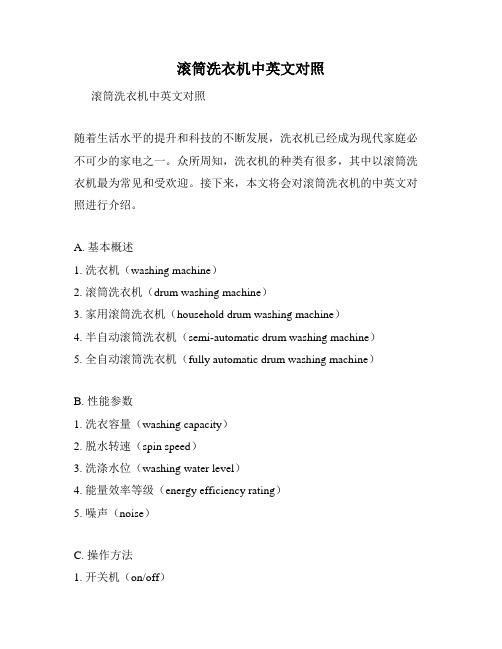
滚筒洗衣机中英文对照滚筒洗衣机中英文对照随着生活水平的提升和科技的不断发展,洗衣机已经成为现代家庭必不可少的家电之一。
众所周知,洗衣机的种类有很多,其中以滚筒洗衣机最为常见和受欢迎。
接下来,本文将会对滚筒洗衣机的中英文对照进行介绍。
A. 基本概述1. 洗衣机(washing machine)2. 滚筒洗衣机(drum washing machine)3. 家用滚筒洗衣机(household drum washing machine)4. 半自动滚筒洗衣机(semi-automatic drum washing machine)5. 全自动滚筒洗衣机(fully automatic drum washing machine)B. 性能参数1. 洗衣容量(washing capacity)2. 脱水转速(spin speed)3. 洗涤水位(washing water level)4. 能量效率等级(energy efficiency rating)5. 噪声(noise)C. 操作方法1. 开关机(on/off)2. 洗涤程序(washing program)3. 清洗程序(cleaning program)4. 脱水程序(spin program)5. 定时启动(delay start)D. 特色功能1. 蒸汽洗烫(steam washing)2. 智能感知(smart sensing)3. 变频技术(frequency conversion technology)4. 柔顺弱脱水(gentle spin)5. 运动洗衣(motion washing)E. 维护保养1. 滚筒清洁(drum cleaning)2. 滤网清洁(filter cleaning)3. 防霉抗菌(mildew and bacterial resistance)4. 水管清洗(pipeline cleaning)5. 定期检修(regular maintenance)总的来说,滚筒洗衣机是一种大家在日常生活中会使用的家电,对于家庭环境来说十分的重要。
关于洗衣机的毕业外文文献翻译、中英文翻译、外文翻译
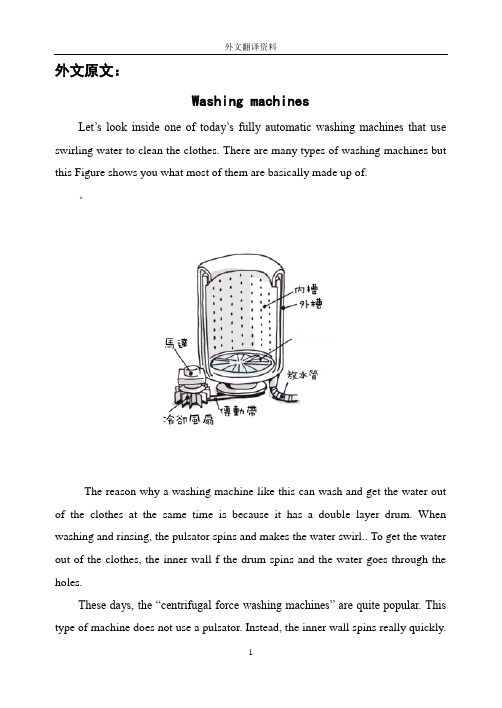
外文原文:Washing machinesLet’s look inside one of today’s fully automatic washing machines that use swirling water to clean the clothes. There are many types of washing machines but this Figure shows you what most of them are basically made up of.。
The reason why a washing machine like this can wash and get the water out of the clothes at the same time is because it has a double layer drum. When washing and rinsing, the pulsator spins and makes the water swirl.. To get the water out of the clothes, the inner wall f the drum spins and the water goes through the holes.These days, the “centrifugal force washing machines” are quite popular. This type of machine does not use a pulsator. Instead, the inner wall spins really quickly.When the drum spins, the dirty clothes get stuck to the wall. The water and detergent also try to escape through the holes of the wall but before they do so, they are forced to escape through the clothes. When this happens, the power of the water and detergent removes the dirt form the clothes. Another good thing about this type of machine is that clothes don’t get tangled up so you don’t have to worry about your clothes getting ripped or damaged.Next, let’s look at some different types of washing machines!Many of you probably think that the water inside washing machines goes round and round. Actually, different washing machines make water flow in different ways.Whirlpool type:This type of washing machine uses a pulsator to force the water to move like a whirlpool inside the Drum. The spinning water forces the dirt out form the clothes inside the machine. Some of the newer models of this type also make the whirlpool move up and down to make it clean clothes even better!Agitator stirring typeThis type of washing machine has something that looks like a propeller at the bottom of the tub. This Propeller spins around and stirs the water. The water then forces the dirt out from the clothes in the machine. The good thing about this type of machine is that clothes do not get tangled up and clothes get evenly washed.Drum type:This type of machine has a drum with many holes in it. There are also protrusions bumps on the wall of the drum. As the drum turns, the clothes are picked up by the protrusions. When the clothes fall down from the top of the drum through the water, the movement removes dirt from the clothes.Centrifugal force type:As we have said before, the spinning drum pushes the water and detergent out through the wall of the inner drum. The power that comes form spinning the drum is called centrifugal force., which is where the name comes from. The water is forced through the clothes and then the holes in the inner wall. After one cycle, the water is recycled back into the tank and the process starts again. This cycle is what cleans the clothes!In Japan, people first started using machines in 1930. But then the price of a washing machine was so high that most average persons could not buy one for their homes.Looking back now, there was something strange and funny on some of the first versions of the washing machine .The machine had two rollers that were used to sandwich each shirt and other clothes to squeeze the water out of them. The rollers were turned by hand, and in fact, you needed a lot of strength to turn those things! Still, people then thought it was a really neat invention! This type of water squeezer was used for almost 30 years until something new came along. The spin drier that used “centrifugal force” to get most of the water is out of the clothes.In 1953, the nozzle type washing machine was first sold in Japan. This washing machine is like the older brother of the swirling washing machine that you see today. The price of these washing machines was lower and because of this, more people bought them. The first fully automatic washing machine was introduced in 1968, and after that, washing clothes became a lot easier to do!There are a lot of different types of washing machines. What kind of washing machine do you have in your house?Fully automatic:The fully automatic machine has two drum layers that wash, rinse and remove water from clothes together. All you have to do is add detergent and put in dirtyclothes and then washing machine will do the rest. There is also a new type of fully automatic washing machine that can dry clothes after they have been washed.Twin tub:This washing machine has one part that dose the washing and another part that does the squeezing. Even though it’s a hassle to take the clothes out and move them to other tub, the good thing is that you can wash and squeeze at the same time with one machine.Front loading:The main feature of front loaders is that they use a lot less water than other types. This is the type of Washing machine that dry cleaners use but a lot of people in western countries have this type of washing machine in their homes too.Let’s try to make the best washing machine in the world!We should already thank the scientists that invented the fully automatic washing machine because it makes washing clothes a piece of cake.Scientists are still trying really hard to find ways to make washing machines a lot handier to use for everyone. Some of the things that they are trying to do are to find better ways of making clothes clean and ways to make washing machines last longer. There are washing machines with d trying function today so you don’t even have to hang clothes after words because it dries them automatically! Amazing!Scientists are also trying to find ways to use less water and less detergent in washing machines at present. This is because that it is better to use less water for preserving the environment.What are washing machines of the future going to be like? Maybe there will be a washing machine that dries and folds your clothes after washing them, or maybe there will be one that will wash your clothes while you are still wearing them! How handy would that be! Remember, if the first washing machine was likea dream to people in the old days, all the dreams you have about washing machines of the future may come true!Now, washing machine is becoming more and more popular. We see the main classification.Washing machine can be divided into automatic type and semi-automatic type two kinds, automatic type washing machine as long as we begin our work proactively set better washing procedure, washing machine began to work until the end without manual intervention. And semi-automatic washing machine washing and dewatering process is divided, is also called the double barrel washing machine, a tong, one takes off a bucket, and put tong inside washing out to artificial add to take off in the barrel dehydration is handled and complete laundry process.Full-automatic washing machine in structure to take off in tong internal bucket suit, two barrels of axis, while working with the clutch to finish washing state and dehydration of the transition of the states, on the key said is automatic washing machine.Full-automatic washing machine press catharsis means to points, can be divided into bunt washer and roll barrel type two kinds of washing machine, From the electric control ways to points, can be divided into mechanical program-controlled type and computer board controls type washing machine two kinds.The cylinder and the pulsator washing machine are now the main two kinds.Pulsator washing machine working principle is to add clothing, then open the inlet valve, choose good bibcock of water level and correct working procedures, switch on the power, closed warehouse door, and safety switch closed at water level, the public internal switch contacts are and dehydration contacts are interlinked, inlet valve electrify water, when the barrel water reaches the specified height, in air pressure under the action of water level switch inside public contactsdisconnect dehydration contacts and connect washing contacts, feed valve power to stop water, motor power is switched on, motor started running, and periodically sometimes are turning, sometimes reverse, mutual alternant, driven by clutch BoLun using the same cycle are turning, inversion, with a certain speed rotating BoLun can drive inside bucket of water and clothing, clothing rotating water formed in the mutual friction and reach the purpose of laundry. When washing process is completed, drainage electromagnetic valve electrify work, drain valve is opened, inside bucket of water exudes, and linkage shaft also the clutch from washing state switch to dehydration state, when drainage is completed, atmospheric pressure drop and inside bucket of water level switch public contacts reset through dehydration contacts, drainage electromagnetic valve keep electrify state, motor driven off running electrify bucket high-speed and jilt dry clothing, laundry program after washing machine disconnect hydropower and stop. As for intermediate process of how many times, laundry to wash the length of time, by process control.Roller-type washing machine of the principle and Pulsator washing machine are basic similar. But 110mm drum machine it no clutch variable speed, but its motor is double-speed motor, so when washing machine work in washing state, program-controlled device connected motor washing low-speed windings, motor speed slow, working on dehydration, when they connect dehydration modalhigh-speed windings, motor high-speed operation, this process is programmed through the device and motor to work together to finish.To sum up, the role of these two kinds of washing machine is same, but different implementation, each has his strong point, Pulsator washing machine is simulated handmade kneaded action to work, 110mm drum type washing machine is by gravity inertial function to finish our work, they realize washing anddewatering way also have different features, Pulsator washing machine to wear clothes is relatively large, but detergents degree is higher, 110mm drum machine for clothing wear small, but detergents degrees, but lower than Pulsator washing machine to save water.So far, washing machine is still towards a higher requirements development.译文:洗衣机来看一下涡流式全自动洗衣机的构造。
西屋洗衣机使用说明书
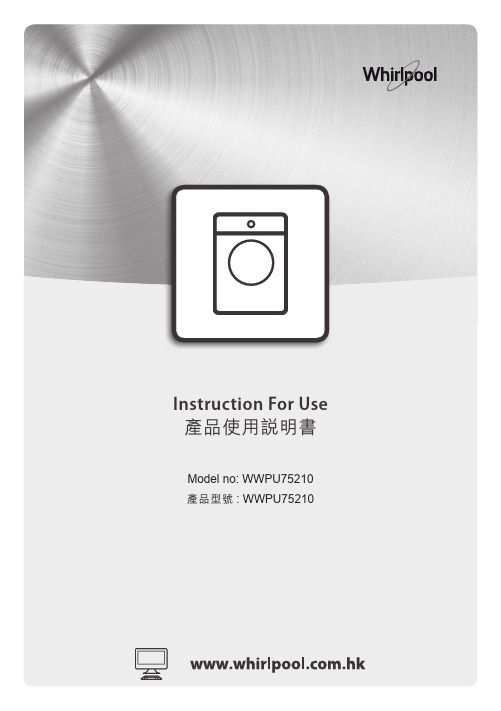
產品使用說明書Instruction For Use2繁體中文332Please read the following instructions carefully before using the device, and keep this user manual for future reference.為了您能更好地使用本產品,請您在使用前仔細閱讀此使用說明書,以發揮本機的最佳效能,並妥善保管好說明畫。
3ENUSER MANUALProduct Safety RulesGeneral Safety Rules 4-5Environmental Conditions 6 Declaration of Conformity7Use and Care guidePractical Tips8Maintenance and Cleaning 9Quick User Guide 10Controls10-14Table of programmes 15Programmes 18Drying Cycle20Automatic Washing/Drying Cycle 22Troubleshooting and Warranty23Installation26Installation Diagram31Index4- Bed and breakfast type environments.- Area for communal use in blocks of flats or in launderettes.• A different use of this appliance from household environment or from typical housekeeping functions, as commercial use by expert or trained users, is excluded even in the above applications.If the appliance is used in a manner inconsistent with this it may reduce the life of the appliance and may void the manufacturer’s warranty. Any damage to the appliance or other damage or loss arising through use that is not consistent with domestic or household use (even if located in a domestic or household environment) shall not be accepted by the manufacturer to the fullest extent permitted by law.• This appliance can be usedby children aged from 8 years and above and persons withreduced physical, sensory or mental capabilities or lack of experience and knowledgeif they have been given supervision or instruction concerning use of the appliance in a safe way and understandthe hazards involved.•Children shall not play withthe appliance. Cleaning anduser maintenance shall not be made by children without supervision.• Children should be supervised to ensure that they do not play with the appliance.• Children of less than 3 years should be kept away unless continuously supervised.• If the supply cord is damaged, it must be replaced by the manufacturer, its service agent or similarly qualified persons in order to avoid a hazard.• Only use the hose-sets supplied with the appliance for the water supply connection (do not reuse old hose-sets).• Water pressure must be between 0.05 MPa and 0.8MPa.• Make sure carpets or rugs do not obstruct the base or any of the ventilation openings.• The OFF condition is reached by placing the reference mark on the programmes control/knob in the vertical position.Any other different position of such control sets the machine in ON condition (only for models with programmes knob).• The final part of a washer dryer cycle occurs without heat (cool down cycle) to ensure that the items are left at a temperature that ensures that the items will not be damaged.Carefully read this manual for correct and safe appliance use and for helpful tips on efficient maintenance.Only use the washing machine after carefully reading these instructions. We recommend you always keep this manual on hand and in good condition for any future owners.Please check that the appliance is delivered with this instruction manual, warranty certificate, service centre address and energy efficiency label. Also check that plugs, drain hose support hook and liquid detergent or bleach tray (only on some models) are included. We recommend you keep all these components.Each product is identified by a unique 16 - character code, also called the “serial number”, printed on the sticker. This can be found inside the door opening. This code is a unique code for your product that you will need to register the product warranty,or if you need to contact the Customer Service Centre.•This appliances is intended to be used in household and similar applications such as:- Staff kitchen areas in shops,offices and other workingenvironments;- Farm houses;- By clients in hotels, motelsand other residential typeenvironments;WARNING General Safety Rules5ENWARNING• Items such as foam rubber (latex foam), shower caps, waterproof textiles, rubber backed articles and clothes or pillows fitted with foam rubber pads should not be dried in the washer dryer.• Fabric softeners, or similarproducts, should be usedas specified by the fabricsoftener instructions.• Oil-affected items can ignite spontaneously, especially whenexposed to heat sources such as a washer dryer. The itemsbecome warm, causing anoxidation reaction in the oil, Oxidation creates heat. If the heat cannot escape, items can become hot enough to catch fire. Piling, stacking or storing oil- effected items can prevent heat from escaping and so create a fire hazard.• If it is unavoidable that fabrics contain vegetable or cooking oil or have been contaminated by hair care products be placed in a washer dryer they should first be washed in hot water with extra detergent - this will reduce, but not eliminate, the hazard.• Remove all objects from pockets such as lighters and matches.• To consult the product technical specification please refer to the manufacturer website.Safety instructions • Before cleaning or maintainingthe washing machine, unplug the appliance and turn off the water tap.• Make sure the electrical system is earthed. Otherwise, seek qualified professional assistance.• Please do not use converters, multiple sockets or extension cords.• Make sure there is no water inthe drum before opening the door.• Do not pull on the power cord or appliance to unplug the machine.• Do not expose the washing machine to rain, direct sunlight or other weather elements. Protect from possible freezing.• When moving, do not liftthe washing machine by the knobs or detergent drawer; during transport, never rest the door on the trolley. Werecommend two people lift the washing machine.•In the event of fault and/or malfunction, turn off the washing machine, close the water tap and do not tamperwith the appliance. Immediately contact the Customer Service Centre and only use original spare parts. Failure to obser ve these instruction may jeopardise appliance safety.water may reach very high temperatures during the wash cycle.never stop a washer dryer before the end of the drying cycle unless all items are quickly removed and spread out so that the heat is dissipated.• This washer dryer must not be supplied through an external switching device, such as a timer, or connected to a circuit that is regularly switched onand off by a utility.• This washer dryer is not intended to be operated by separate remote-control system.Correct UseAfter installation, the appliancemust be positioned so that theplug is accessible.• The appliance must not beinstalled behind a lockabledoor, a sliding door or a doorwith a hinge on the opposite side to that of the washer dryer, in such way that a full opening of the washer dryer door is restricted.• The maximum load capacityof dry clothes depends on the model used (see control panel).• The appliance is not to be used if industrial chemicals have been used for cleaning.• Do not dry unwashed items inthe washer dryer.• Items that have been soiledwith substances such as cooking oil, acetone, alcohol, petrol, kerosene, spot removers,turpentine, waxes and wax removers should be washed in hot water with an extra amountof detergent before being dried in the washer dryer.WARNING6This appliance is marked according to the European directive 2012/19/EU on Waste Electrical and Electronic Equipment (WEEE).WEEE contains both polluting substances (which can cause negative consequences for the e n v i r o n m e n t ) a n d b a s i c components (which can be re-used). It is important to have WEEE subjected to specific treatments, in order to remove and dispose properly all pollutants, and recover and recycle all materials. Individuals can play an important role in ensuring that WEEE does not become an environmental issue; it is essential to follow some basic rules:• WEEE should not be treated as household waste;• WEEE should be handed over to the relevant collection points managed by the municipality or by registered companies.In many countries, when you buy a new appliance, the old one may be returned to the retailer who has to collect it free of charge on a one-to-one basis, as long as the equipment is of equivalent type and has the same functions as the supplied equipment.Environmental ConditionsEN Declaration of ConformityBy placing the mark on this product,we are confirming compliance to allrelevant European safety, health andenvironmental requirements which areapplicable in legislation for this product.78Practical Tips- have eliminated metallic objects such as hair clips, pins, coins, from laundry;- to have buttoned pillow cases, closed zips, tied loose belts and long robe ribbons;- to have removed rollers, hooks or clips from curtains;- to have carefully read clothing washing labels;- to have removed any persistent stains using specific detergents.• When washing rugs, bedcovers or other heavy clothing, we recommend you avoid the spinning cycle.• To wash wool, make sure the item can be machine washed and marked by the “Pure virgin wool” symbol with the “Does not mat ”or” Machine washable” label.Helpful suggestions for the userA guide environmentally friendly and economic use of your appliance.Maximise The Load Size• Achieve the best use of energy, water, detergent and time by using the recommended maximum load size.Save up to 50% energy by washing a full load instead of 2 half loads.Do you need to pre-wash?• For heavily soiled laundry only!SAVE detergent, time, water and between 5 to 15% energy consumption by NOT selecting Prewash for slight to normally soiled laundry.Is a hot wash required?• Pretreat stains with stain remover or soak dried in stains in water before washing to reduce the necessity of a hot wash programme.Save up to 50% energy by using a 60°C wash programme.Before using a drying programme...• SAVE energy and time by selecting a high spin speed to reduce the water content in laundry before using a drying programme.Following is a quick guide with tips and recommendations on detergent use at the various temperatures . In any case, always read the instructions on the detergent for correct use and doses.For washing at temperatures below 40°C we recommend the use of liquid detergents or detergents specifically labeled as suitable for low temperature washing.When washing heavily soiled whites, we recommend using cotton programs of 60°C or above and a normal washing powder (heavy duty) that contains bleaching agents that at medium/high temperatures provide excellent results.For washes between 40°C and 60°C the type of detergent used needs to be appropriate for the type of fabric and level of soiling.Normal powders are suitable for “white” or colour fast fabrics with high soiling, while liquid detergents or “colour protecting” powders are suitable for coloured fabrics with light levels of soiling.For washing wool or silk , only use detergents specifically formulated for these fabrics.9ENhousing.• Ensure the siphon cap is correctly refitted.Filter cleaning• The washing machine comes with a special filter able to trap large residue, such as buttons or coins, which could clog the drain.• Only available on certain models: pull out the corrugated hose, remove the stopper and drain the water into a container.• Ensure all the water has been emptied from the drum.• Before unscrewing the filter, we recommend you place an absorbent cloth under it to keep the floor dry. A small amount of water will come out of the filter as you remove it - this is normal.• Turn the filter counter-clockwise to the limit stop.• Remove and clean the filter; when finished, replace it turning it clockwise. The filter handle will be locked when it is not possible to turn any further and the handle is horizontal. Smearing a small amount of liquid soap on the filter seal will help refitting.• Repeat the previous steps in reverse order to reassemble all parts.Suggestions for moves or prolonged disuse • Should the washing machine be stored in an unheated room for a long period of time, drain all water from tubes.• Unplug the washing machine.• Detach the tube from the drainage system and clip on the rear of the machine and lower it, fully draining water into a bowl.• Secure the drain tube with the drainage system and clip on the rear of the machine when finished.• Keep the door glass and gasket clean.10PROGRAMME selector with OFF position • Press the START/PAUSE button to start the selected cycle.• Once a programme is selected the PROGRAMME selector remains stationary on the selected programme till cycle ends.• “End” will appear in the display at the end of the program and the DOOR LOCKED inducator light will go off, it is now possible to open the door.• Switch off the washing machine indicator by turning the selector to OFF .START / PAUSE button• Press to start the selected cycle.When the programme selector is turned the display lights up to show the settings for the programme selected.For energy saving, at the end of the cycle or with an inactivity period, the display level contrast will decrease.N.B.: To switch the machine off, turn the programme selector to the OFF position.The PROGRAMME selector must be returned to the OFF position at the end of each cycle or when starting a subsequent wash cycle prior to the next programme being selected and started.Close the door BEFORE selecting the button START/PAUSE.When the START/PAUSE button has been pressed, the appliance can take few seconds before it starts working.ADD OR REMOVE I TEMS AFTER THE PROGRAMMES HAS STARTED (PAUSE)• Press and hold the START/PAUSE button for about 2 seconds (some indicator lights and the time remaining indicator will flash, showing that the machine has been paused).• Wait until the DOOR LOCKED indicator light has gone out before opening the door.• After you have added or removed items, close the door and press the START/PAUSE button (the programme will start from where it left off).CANCELLING THE PROGRAMME• To cancel the programme, set the selector to the OFF position.• Wait 2 minutes until the safety device unlocks the door.DELAY START button• This button allows you to pre-programme the wash cycle to delay the start of the cycle for up to 24 hours .• To delay the start use the following procedure:- Select the required programme.- Press the delay start button once to activate it (h00 appears on the display) and then press it again to set a 1 hour delay (h01 appears on the display). The pre-set delay increases by 1 hour each time the button is pressed, until h24 appears on the display, at which point pressing the button again will reset the delay start to zero.Before you open the door, please check water level is below the door opening to avoid flooding.- Confirm by pressing the START/PAUSE button. The delay countdown will begin and when it has finished the programme will start automatically.• It is possible to cancel the delay start by turning the programme selector to OFF .If there is any break in the power supply while the machine is operating, a special memory stores the selected programme and, when the power is restored, it continues where it left OFF.• Drying only cycle:select via the knob the desired drying programme in conjunction with your fabrics, by pressing this button it is possible to select a degree of dryness that is different to the default one (except for the wool drying programme).• To cancel the cycle during the drying phase , please press the button for about 3 seconds .DRYING SELECTION button• For automatic washing/drying cycle: after the selection of washing programme according to laundry type, select a degree of dryness by pressing this button. At the end of the washing programme, the selected drying cycle will start automatically.If a washing programme is not compatible with automatic drying selected, this function will not be activated.• If you want delete the selection before the programme starts , please press repeatedly the button until the lights go off or reposition the programme selector to the OFF position.The option buttons should be selected before pressing the START/PAUSE button. If an option is selected that is not compatible with the selected programme then the option indicator lights first flashes and then goes off.I t is also possible to cancel the drying cycle by turning the programme selector to the OFF position. I t is necessary to wait for the cooling phase’s end (10/20 minutes) and the DOOR LOCKED indicator light to go off before opening the door.If you exceed the maximum dryable load of laundry indicated in the programme table, the laundry may not be dried satisfactory.• “End” will appear in the display at the end of the program and the DOOR LOCKED indicator light will go off, it is now possible to open the door.QUICK / STAIN LEVEL buttonThis button allows you to choose between two different options, depending on the selected programme.- QUICKThe button becomes active when you select the QUICK (14/30/44 Min.) programme on the knob and allows you to select one of three durationsindicated.- STAIN LEVEL button• Once the programme has been selected the wash time set for that programme will be automatically shown.• This option allows you to choose between 3 levels of wash intensity modifying the lengthof the programme, depending on how much the fabrics are soiled (can only be used on some programmes as shown in the table of programmes).TEMPERATURE SELECTION button• This button allows you to change the temperature of the wash cycles.• It is not possible to raise the temperature over the maximum allowed for the programme, in order to protect the fabrics.• If you want carry out a cold wash all the indicators must be off.SPIN SPEED button• By pressing this button, it is possible to reduce the maximum speed, and if you wish, the spin cycle can be cancelled.• If the label does not indicate specific information, it is possible to use the maximum spin expected in the program.• To reactivate the spin cycle press the button until you reach the spin speed you would like to set.• It is possible to modify the spin speed without pausing the machine.KEY LOCK• Pressing simultaneously the buttons TEMPERATURE SELECT ON and SP N SPEED for about 3 seconds, the machine allows you to lock the keys. In this way, you can avoid making accidental or unwanted changes if a button on the display is pressed accidently during a cycle.• The key lock can be simply cancelled by pressing the two buttons simultaneously again or turning off the appliance.Digital DisplayThe display’s indicator system allows you to be constantly informed about the status of the machine.1) DRYING SELECTION INDICATOR LIGHTSThe indicators display the degrees of dryness that can be selected by the relevant button:EXTRA DRY(suitable for towels, bathrobes and bulkyloads).IRON DRY(that leaves the laundry ready for ironing).CUPBOARD DRY(for items that will be put away withoutironing).To prevent damage to the fabrics, it is not possible to increase the speed over the maximum allowed for the programme.An over dosing of detergent can cause excessive foaming. I f the appliance detects the presence of excessive foam, it may exclude the spinning phase or extend the duration of the program and increase water consumption.The machine is fitted with a special electronic device, which prevents the spin cycle should the load be unbalanced. This reduces the noise and vibration in the machine and soprolongs the life of your machine.2) CYCLE DURATION• When a programme is selected the display automatically shows the typical cycle duration, which can vary, depending on the options selected.• During the initial filling phase of the cycle the machine calculates the actual cycle time needed based on the load size, content and options selected. The real time of the wash will then be displayed. This time can recaulculate during the wash depending on detergent levels and load balancing.3) DOOR LOCKED INDICATOR LIGHT• The indicator light is illuminated when the door is fully closed.• When START/PAUSE is pressed on the machine with the door closed, the indicator will flash momentarily and then illuminate.• Wait until the DOOR LOCKED indicator light has gone out before opening the door.Kg LOAD ND CATOR L GHT (function active only on certain programmes)• During the first minutes of the cycle, the “Kg LOAD” indicator will remain on while the intelligent sensor will weigh the laundry and adjust the cycle time, water and electricity consumption accordingly.• Through every wash phase “Kg LOAD” allows to monitor information on the wash load in the drum and in the first minutes of the wash it:- adjusts the amount of water required;- determines the length of the wash cycle;- controls rinsing according to the type of fabric selected to be washed it;- adjusts the rhythm of drum rotation for the type of fabric being washed;- recognises the presence of too much soap suds, and if necessary, adjust the amount of rinse water.- adjusts the spin speed according to the load, thus avoiding any imbalance.5) KEY LOCK INDICATOR LIGHTThe indicator light show that the keys are locked. 6) WASH TEMPERATURE INDICATOR LIGHTS This shows the washing temperature of the selected programme that can be changed (where allowed) by the relevant button.If you want carry out a cold wash all the indicators must be off.7) SPIN SPEED INDICATOR LIGHTSThis shows the spin speed of the selected programme, that can be reduced or omitted by the relevant button.Close the door BEFORE selecting the START/ PAUSE button.If the door is not properly closed, the light will continue to flash for about 7 seconds, after which the start command will be automatically cancelled. In this case, close the door in the proper way and press the START/PAUSE button.Table of programmesMax. Spin Speed: 1200 rpmPlease read these notes:* Maximum load capacity of dry clothes,according to the model used (see control panel).•When a programme is selected, on the display is shown the display shows the recommended wash temperature that can be reduced (where allowed) by the relevant button.•For the programmes shown you can adjust the duration and intensity of the wash using the STAIN LEVEL button.•Selecting the QUICK program on the knob, it will be possible to select with the QUICK button, one of the three QUICK programs available among 14’, 30’ and 44’.•Programmes for automatic drying.Programmes selectionTo clean different types of fabrics and various levels of dirt, the washing machine has specific programs to meet every need of washing (see table of programmes).WASHINGCottonAn intensive wash. The final spin at maximum speed gives more efficient removal.Cotton + PrewashThis programme has been designed to remove the stronger stains from cotton white clothes. The prewash guarantees the tough dirt removal. Add into compartment “1” a quantity of detergent equal to 20% of that used for main wash.CottonThis program is suitable to clean normally soiled cotton laundry and it is the most efficient program in terms of combined energy and water consumptions for washing cotton laundry.Eco 20°This innovative programme, allows you to wash different fabrics and colours together, such as cottons, synthetics and mixed fabrics at only 20°C and provides an excellent cleaning performance. Consumption on this program is about 40% of a conventional 40°C cottons wash.MixedThe washing and rinsing optimise the speed and rhythm of the drum action and water levels. The gentle spin, ensures a reduced formation of creases in the fabric.DelicatesThis program has reduced periods of drum rotation during the cycle and is particularly.RinseThis program per forms 3 rinses with an intermediate spin (which can be reduced or excluded by using the appropriate button). It is used for rinsing any type of fabric, for example after a wash carried out by hand.SpinThe programme carries out a maximum spin. It is possible to delete or reduce the spin with the SPIN SPEED button.DrainThis programme drains out the water.QUICK (14/30/44 Min.)Washing cycle suggested for low loads and slightly dirty. With this program it is recommended to reduce the quantity of detergent normally used, in order to avoid unnecessary waste. Selecting the QUICK program and acting on the button you can choose one of three programs available. ShirtsThe washing cycle is optimized to reduce the creation of creases, keeping an excellent washing performance. It is also possible to further reduce the spin speed, to ensure an easier ironing.WoolThis program performs a wash cycle dedicated to the wool fabrics that can be washed in a washing machine, or the articles to be washed by hand.Hand WashProgram for hand wash only clothes, the program ends with 3 rinses and a slow spin. suitable or washing delicate fabrics. The wash cycle and rinses are carried out with a high level of water to ensure the best performance.The drum changes direction during the drying cycle to prevent the laundry from tangling and producing even more drying.Cool air is used during the last 10/20 minutes of the drying cycle to minimize creasing.DRYING Synthetics (Low Heat)Low temperature drying programme recommended for synthetics and mixed fibres (always refer to the laundry care label).Cottons (High Heat)High temperature drying programme recommended for cottons and linen items (always refer to the laundry care label).•Drying guidance advice is general, but practical experience of using the product will help you to achieve the best drying results.•We recommend setting a lower drying time than indicated, when first using the appliance in order to establish the degree of dryness required.•We recommend not drying fabrics that fray easily, such as rugs or garments with a deep pile, in order to avoid air duct clogging.•We recommend that you sort the laundry by the following methods:- By drying care symbols, which are displayed on the clothing labels - By size and thicknessWhenever the wash load is bigger than the drying capacity, separate the clothes according to thickness (e.g. towels from thin underwear).- By fabric typeCottons/linen: towels, cotton jersey, bed and table linen.Synthetics: blouses, shirts, overalls, etc. made of polyester or polyamide, as well as for cotton/synthetic mixes.•Only dry pre-spun laundry.Drying CycleIf the fabric does not have a care label, you should assume that it is not suitable for drying.Suitable for tumble drying.Tumble dry at high temperature.Tumble dry at low temperature only.DO NOT tumble dry.EXTRA DRY(suitable for towels, bathrobes and bulky loads).IRON DRY(that leaves the laundry ready for ironing).CUPBOARD DRY(for items that will be put away without ironing).The correct way to dry •Open the door.•Fill with the laundry, not exceeding the maximum drying load indicated in the programme table. For large items (e.g. sheets)or very absorbent items (e.g. towels or jeans), it is a good idea to reduce the load.•Close the door.•Turn the programme dial to the more suitable drying programme for your laundry.•The washer dryer can perform the following types of drying:- Low temperature dr ying programme recommended for mixed fabrics (synthetics/cotton) synthetic fabrics (Synthetics Dry symbol on programme dial).- High temperature dr ying programme recommended for cotton, terry toweling, linen, hemp fabrics, etc... (Cotton Dry symbol on programme dial).•Select the degree of dryness that you require:。
服装洗涤说明图标与中英文
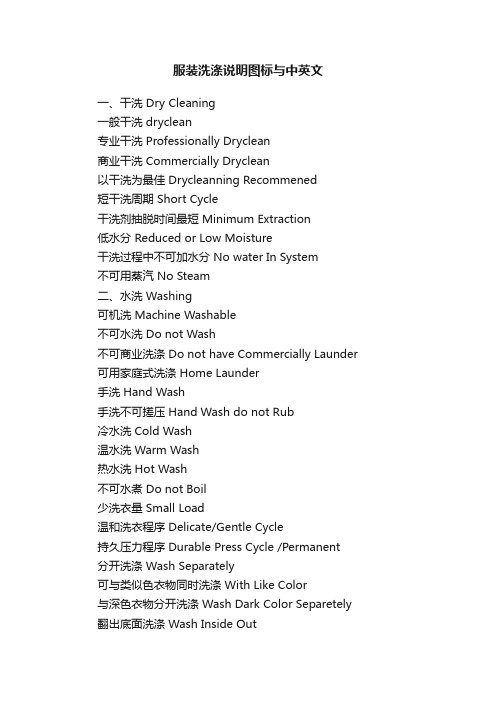
服装洗涤说明图标与中英文一、干洗 Dry Cleaning一般干洗 dryclean专业干洗 Professionally Dryclean商业干洗 Commercially Dryclean以干洗为最佳 Drycleanning Recommened短干洗周期 Short Cycle干洗剂抽脱时间最短 Minimum Extraction低水分 Reduced or Low Moisture干洗过程中不可加水分 No water In System不可用蒸汽 No Steam二、水洗 Washing可机洗 Machine Washable不可水洗 Do not Wash不可商业洗涤 Do not have Commercially Launder 可用家庭式洗涤 Home Launder手洗 Hand Wash手洗不可搓压 Hand Wash do not Rub冷水洗 Cold Wash温水洗 Warm Wash热水洗 Hot Wash不可水煮 Do not Boil少洗衣量 Small Load温和洗衣程序 Delicate/Gentle Cycle持久压力程序 Durable Press Cycle /Permanent分开洗涤 Wash Separately可与类似色衣物同时洗涤 With Like Color与深色衣物分开洗涤 Wash Dark Color Separetely 翻出底面洗涤 Wash Inside Out不可拧干 No Wring/ Do not Wring不可拧绞 No Twist/ Do not Twist温水清洗 Warm Rinse冷水清洗 Cold Rinse彻底清洗 Rinse Thoroughly不可脱水 No Spin/ Do not Spin普通旋转速度脱水 Normal Spin较短较慢程序脱水 Reduced Spin不可浸泡 Do not Soak只可用皂片 Use Pure Soap Flake only只可抹洗或擦洗 Damp Wipe only三、漂白 Bleaching需要时漂白 Bleaching when Needed不可漂白 No bleach / Do not Bleach只可用非氯性漂白剂 Only Non-Chlorine Bleach 四、干衣 Drying滴干 Drip Dry挂干 Line Dry荫凉挂干 Line Dry in Shade避热挂干 Line Dry away from Heat用烘干机烘干 Tumble Dry用烘干机中温烘干 Tumble Warm用烘干机低温烘干 Tumble Cool平铺晒干 Flat Dry定位干衣 Block to Dry用蒸汽烘干 Steam Dry不用蒸汽 No Steam / Do not Steam风柜吹干 Cabinet Dry Cool五、熨烫 Ironing and Pressing热烫 Hot Iron温烫 Warm Iron低温烫 Cold Iron不可熨 Do not Iron反面熨 Iron on Wrong Side用蒸汽熨烫 Steam Press/Iron在湿润时熨烫 Iron Damp用布间隔熨烫 Use Press Cloth外包装 bale箱 carton件 package色号 colour number花号 design number批号 lot number唛头 marks装箱单 packing list漏验 omisson of examination漏验率 percentage of omisson of examination 复验 re-inspection索赔 claim indemnity毛重 gross weight净重 net weight外观质量 appearance quality内在质量 inherent quality外观疵点 appearance技术要求 technical requirement感观检验 subjective inspection取样 samoling品质检验单 inspection certificate for quality 检验证书 inspection certificate织物重量 fabric weight断裂强力 breaking strength 断裂强度 breaking tenac。
洗衣机安全使用英语作文
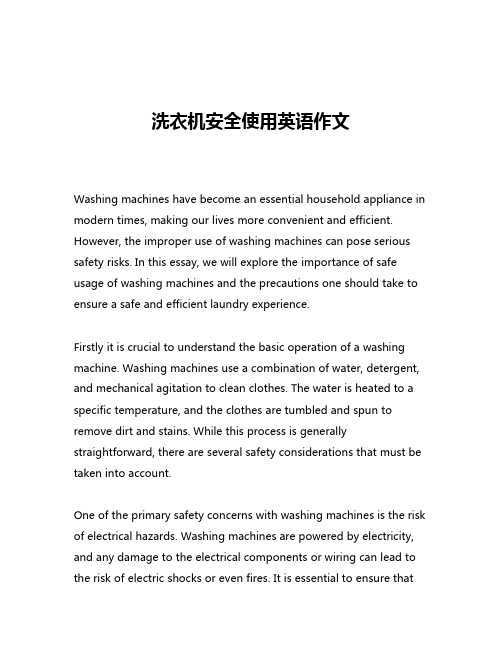
洗衣机安全使用英语作文Washing machines have become an essential household appliance in modern times, making our lives more convenient and efficient. However, the improper use of washing machines can pose serious safety risks. In this essay, we will explore the importance of safe usage of washing machines and the precautions one should take to ensure a safe and efficient laundry experience.Firstly it is crucial to understand the basic operation of a washing machine. Washing machines use a combination of water, detergent, and mechanical agitation to clean clothes. The water is heated to a specific temperature, and the clothes are tumbled and spun to remove dirt and stains. While this process is generally straightforward, there are several safety considerations that must be taken into account.One of the primary safety concerns with washing machines is the risk of electrical hazards. Washing machines are powered by electricity, and any damage to the electrical components or wiring can lead to the risk of electric shocks or even fires. It is essential to ensure thatthe washing machine is properly grounded and that the electrical connections are in good condition. Additionally, it is crucial to avoid using the washing machine in damp or wet environments, as this can increase the risk of electrical accidents.Another important safety concern is the risk of water leaks. Washing machines use a significant amount of water during the washing cycle, and any leaks can lead to water damage to the surrounding area. This can not only cause property damage but also create a slip and fall hazard. To mitigate this risk, it is essential to regularly inspect the washing machine for any signs of leaks, such as water pooling around the machine or wet floors. If any leaks are detected, it is crucial to address them promptly to prevent further damage.The loading and unloading of the washing machine can also pose safety risks. Heavy or bulky items, such as blankets or comforters, can be difficult to maneuver and may cause strain or injury if not handled properly. It is essential to use proper lifting techniques, such as bending at the knees and keeping the back straight, when loading or unloading the washing machine. Additionally, it is crucial to ensure that the washing machine is not overloaded, as this can lead to imbalances and potentially cause the machine to become unstable or even tip over.Another important safety consideration is the use of appropriatedetergents and cleaning products. Some detergents and cleaning products can be hazardous if not used properly, and they may cause skin irritation or other health issues if they come into direct contact with the skin. It is essential to follow the manufacturer's instructions carefully and to use only the recommended amount of detergent or cleaning product. Additionally, it is crucial to keep these products out of the reach of children to prevent accidental ingestion or exposure.Finally, it is essential to regularly maintain and service the washing machine to ensure its safe and efficient operation. This includes cleaning the lint filter, checking the hoses for any signs of wear or damage, and ensuring that the machine is level and properly balanced. Regular maintenance can help extend the lifespan of the washing machine and prevent potential safety issues.In conclusion, the safe use of washing machines is essential to ensure the safety of both the user and the surrounding environment. By understanding the basic operation of the washing machine, taking precautions to mitigate electrical and water-related hazards, using proper loading and unloading techniques, and maintaining the machine regularly, individuals can enjoy a safe and efficient laundry experience. By prioritizing safety, we can ensure that washing machines continue to be a valuable and reliable household appliance for years to come.。
洗衣机使用过程英语作文
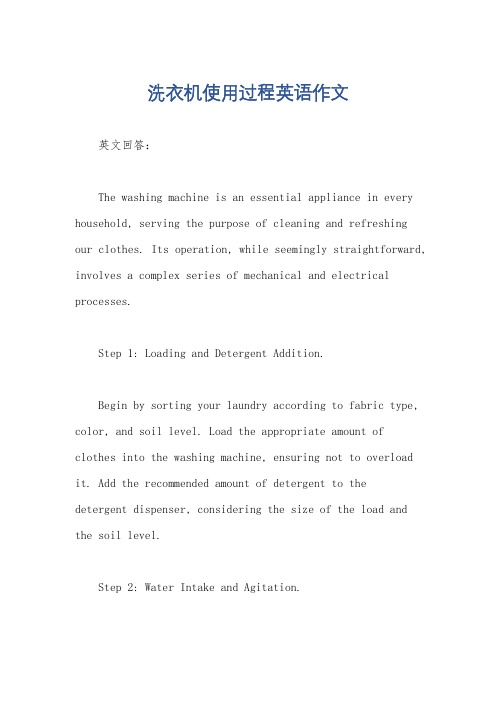
洗衣机使用过程英语作文英文回答:The washing machine is an essential appliance in every household, serving the purpose of cleaning and refreshing our clothes. Its operation, while seemingly straightforward, involves a complex series of mechanical and electrical processes.Step 1: Loading and Detergent Addition.Begin by sorting your laundry according to fabric type, color, and soil level. Load the appropriate amount ofclothes into the washing machine, ensuring not to overload it. Add the recommended amount of detergent to thedetergent dispenser, considering the size of the load and the soil level.Step 2: Water Intake and Agitation.The washing machine fills with water through the inlet valve, reaching the desired water level. The water level is typically determined by the load size and the selected wash cycle. The agitator or drum rotates to mix the clothes with the detergent solution, creating friction and looseningdirt and stains.Step 3: Washing Cycle.The washing cycle consists of several stages:Wash: The agitator or drum continues rotating,ensuring thorough mixing of the detergent solution and clothes. The water temperature is maintained at a specific level, depending on the selected wash cycle.Rinse: After the wash cycle is complete, the washing machine drains the dirty water and refills with clean water. The agitator or drum rotates to rinse the clothes, removing detergent residue and dirt.Spin: Once the rinse cycle is complete, the washingmachine spins at a high speed to remove excess water from the clothes. This process helps reduce drying time.Step 4: Draining and Drying.The washing machine drains the remaining water through the drain hose. Depending on the model, you may choose to dry the clothes in the washing machine using the built-in dryer or transfer them to a separate dryer.Step 5: Maintenance.Regular maintenance is crucial for optimal performance and longevity of your washing machine. Clean the detergent dispenser and lint filter regularly to prevent buildup and ensure proper operation. Conduct periodic checkups to identify any potential issues that may require professional attention.中文回答:洗衣机的使用步骤。
全自动洗衣机英文操作流程
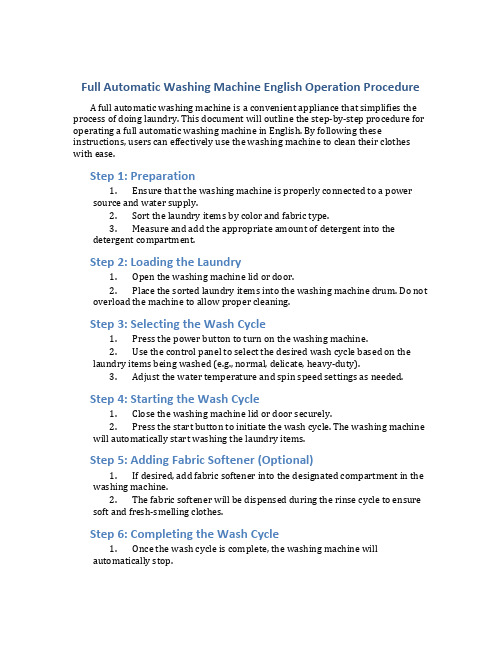
Full Automatic Washing Machine English Operation ProcedureA full automatic washing machine is a convenient appliance that simplifies the process of doing laundry. This document will outline the step-by-step procedure for operating a full automatic washing machine in English. By following these instructions, users can effectively use the washing machine to clean their clothes with ease.Step 1: Preparation1.Ensure that the washing machine is properly connected to a powersource and water supply.2.Sort the laundry items by color and fabric type.3.Measure and add the appropriate amount of detergent into thedetergent compartment.Step 2: Loading the Laundry1.Open the washing machine lid or door.2.Place the sorted laundry items into the washing machine drum. Do notoverload the machine to allow proper cleaning.Step 3: Selecting the Wash Cycle1.Press the power button to turn on the washing machine.e the control panel to select the desired wash cycle based on thelaundry items being washed (e.g., normal, delicate, heavy-duty).3.Adjust the water temperature and spin speed settings as needed.Step 4: Starting the Wash Cycle1.Close the washing machine lid or door securely.2.Press the start button to initiate the wash cycle. The washing machinewill automatically start washing the laundry items.Step 5: Adding Fabric Softener (Optional)1.If desired, add fabric softener into the designated compartment in thewashing machine.2.The fabric softener will be dispensed during the rinse cycle to ensuresoft and fresh-smelling clothes.Step 6: Completing the Wash Cycle1.Once the wash cycle is complete, the washing machine willautomatically stop.2.Open the lid or door of the washing machine and remove the cleanlaundry items.3.Close the lid or door of the washing machine to prevent any waterspillage.Step 7: Drying the Laundry1.Depending on the fabric type and personal preference, either transferthe laundry to a dryer or hang them up to air dry.ConclusionOperating a full automatic washing machine in English is a straightforward process that can be easily mastered by following the above steps. By understanding the operation procedure, users can effectively utilize the features of the washing machine to achieve clean and fresh-smelling laundry.。
洗衣机使用流程英文版
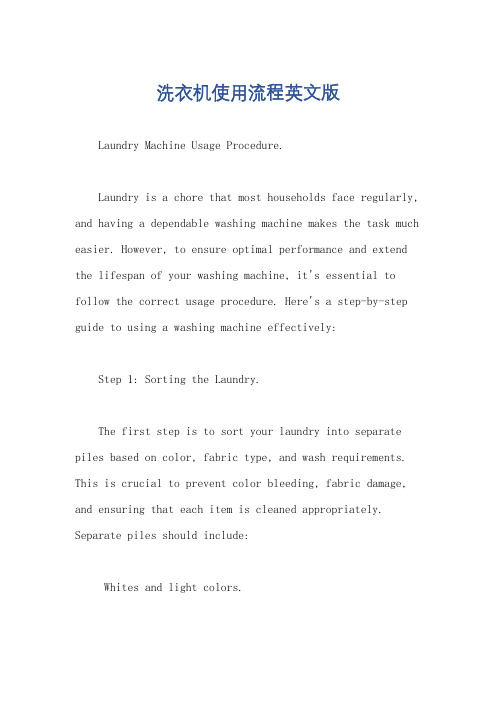
洗衣机使用流程英文版Laundry Machine Usage Procedure.Laundry is a chore that most households face regularly, and having a dependable washing machine makes the task much easier. However, to ensure optimal performance and extend the lifespan of your washing machine, it's essential to follow the correct usage procedure. Here's a step-by-step guide to using a washing machine effectively:Step 1: Sorting the Laundry.The first step is to sort your laundry into separate piles based on color, fabric type, and wash requirements. This is crucial to prevent color bleeding, fabric damage, and ensuring that each item is cleaned appropriately. Separate piles should include:Whites and light colors.Dark colors.Delicates and fabrics that require gentle washing.Heavily soiled items.Items that require special care or treatment.Step 2: Preparing the Laundry.Before loading the laundry into the washing machine,it's important to prepare the items. This involves checking pockets for any forgotten items, zipping or buttoning up garments to prevent tangling, and turning garments inside out if necessary to protect the fabric.Step 3: Choosing the Right Cycle.The next step is to select the appropriate washing cycle based on the type of laundry you have. Modern washing machines offer a variety of cycles for different fabrics and soil levels. Common cycles include:General/Mixed Fabrics.Delicates/Handwash.Heavy Duty/Tough Stains.Quick Wash.Wool/Special Fabrics.Read the care labels on your clothes and select the cycle that best suits the fabrics and soiling level of your laundry.Step 4: Adding Detergent and Fabric Softener.Once you've chosen the cycle, it's time to add the detergent and fabric softener. Measure the recommended amount of detergent based on the size of your load and pour it into the designated compartment of the washing machine. If using fabric softener, add it to the separatecompartment meant for that purpose. Some machines allow you to add detergent and softener directly into the drum, but it's best to follow the manufacturer's instructions.Step 5: Loading the Laundry.Carefully load the laundry into the machine, starting with the heavier or bulkier items. Distribute the laundry evenly to avoid overloading or tangling. Be sure to check the manufacturer's recommendations regarding the maximum load capacity of your machine.Step 6: Starting the Cycle.Once the laundry is loaded, close the door and select the desired cycle. Adjust the wash temperature and spin speed if necessary, depending on the fabric type and care instructions. Finally, press the start button to initiate the cycle.Step 7: Monitoring the Cycle.During the washing cycle, it's important to monitor the progress. If your machine has a display panel, it will indicate the current stage of the cycle. Listen to the machine and check periodically to ensure it's operating normally. If any abnormalities are noticed, such as excessive noise or vibration, stop the cycle immediately and check for any obstructions or issues.Step 8: Ending the Cycle.Once the cycle is complete, the machine will automatically stop. Open the door and carefully remove the laundry. Check for any remaining detergent or softener residue and rinse off if necessary. Then, transfer the laundry to the dryer or hang them to dry depending on your preference.Step 9: Cleaning and Maintenance.After using the washing machine, it's important to perform regular cleaning and maintenance to keep it in good condition. Wipe down the inside of the drum with a dampcloth to remove any lint or residue. Check and clean the detergent and softener compartments, and empty the lint trap if your machine has one. Additionally, it's recommended to run an empty cycle with vinegar or a dedicated washing machine cleaner to remove any buildup of detergent or mold.Conclusion.Using a washing machine correctly not only ensures optimal cleaning results but also prolongs the lifespan of the appliance. By following the steps outlined in this guide, you can enjoy effortless laundry days while protecting your clothes and the environment. Remember to always read the care labels on your clothes, follow the manufacturer's instructions for your washing machine, and perform regular cleaning and maintenance to keep your machine running smoothly.。
洗衣机使用流程英语作文
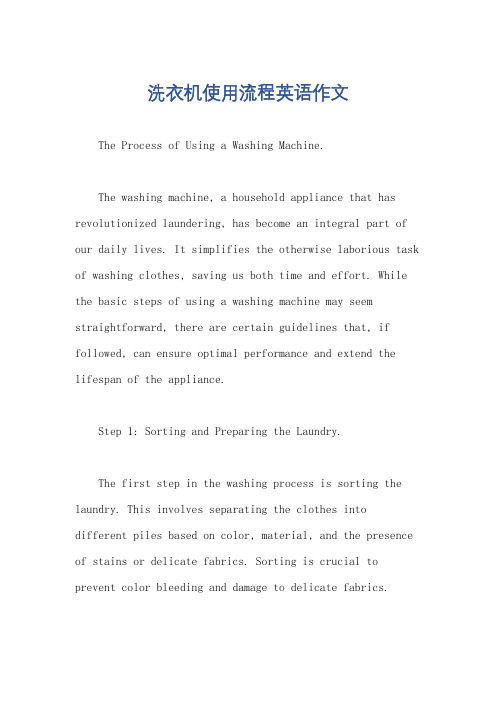
洗衣机使用流程英语作文The Process of Using a Washing Machine.The washing machine, a household appliance that has revolutionized laundering, has become an integral part of our daily lives. It simplifies the otherwise laborious task of washing clothes, saving us both time and effort. While the basic steps of using a washing machine may seem straightforward, there are certain guidelines that, if followed, can ensure optimal performance and extend the lifespan of the appliance.Step 1: Sorting and Preparing the Laundry.The first step in the washing process is sorting the laundry. This involves separating the clothes intodifferent piles based on color, material, and the presence of stains or delicate fabrics. Sorting is crucial to prevent color bleeding and damage to delicate fabrics.Once sorted, it's essential to empty the pockets of any loose items that could potentially damage the machine or get trapped in the drum. Items like coins, paper clips, or buttons can cause significant harm if not removed.Step 2: Pre-treating Stains.Before loading the laundry into the machine, it's advisable to pre-treat any stubborn stains. This can be done using a stain remover or a suitable household product. Apply the treatment directly to the stain and allow it to sit for a few minutes before washing.Step 3: Loading the Washing Machine.When loading the washing machine, it's important to distribute the laundry evenly inside the drum. This ensures that the clothes are properly washed and do not tangle. Delicate items or those that require gentle handling should be placed in a separate delicates bag or on a gentle cycle.Step 4: Adding Detergent and Fabric Softener.Choosing the right detergent for the type of laundry is crucial. Measure the recommended amount of detergent according to the load size and add it to the designated compartment in the machine. Fabric softener, if desired, should be added to the softener dispenser.Step 5: Selecting the Appropriate Wash Cycle.The wash cycle should be selected based on the type of laundry and the desired cleaning results. Modern washing machines offer a range of cycles, including gentle, heavy-duty, quick wash, and specialized cycles for delicates or specific fabrics. Selecting the appropriate cycle ensures that the clothes are washed effectively while protecting them from damage.Step 6: Starting the Wash Cycle.Once the laundry is loaded, detergent is added, and the cycle is selected, it's time to start the wash cycle. Close the door securely and press the start button. The machinewill then proceed through the washing, rinsing, and spin cycles as programmed.Step 7: Checking and Removing the Laundry.Once the wash cycle is complete, it's important to check the laundry before removing it from the machine. This allows for any remaining items or tangled clothes to be untangled. Gently remove the laundry and hang or fold it according to preference.Step 8: Cleaning and Maintaining the Washing Machine.Regular cleaning and maintenance of the washing machine are essential to its longevity and performance. This includes wiping down the exterior, cleaning the lint trap, and checking the hoses and connections for any leaks or damage.In conclusion, using a washing machine effectively requires attention to detail and following a set of guidelines. By sorting the laundry, pre-treating stains,loading the machine correctly, selecting the appropriate cycle, and maintaining the appliance, we can ensure that our clothes are washed efficiently while protecting the investment we have made in our washing machine.。
滚筒洗衣机操作方法英文
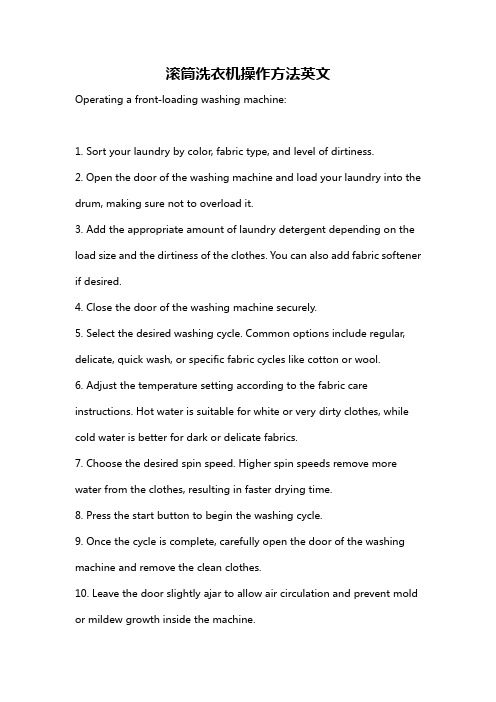
滚筒洗衣机操作方法英文Operating a front-loading washing machine:1. Sort your laundry by color, fabric type, and level of dirtiness.2. Open the door of the washing machine and load your laundry into the drum, making sure not to overload it.3. Add the appropriate amount of laundry detergent depending on the load size and the dirtiness of the clothes. You can also add fabric softener if desired.4. Close the door of the washing machine securely.5. Select the desired washing cycle. Common options include regular, delicate, quick wash, or specific fabric cycles like cotton or wool.6. Adjust the temperature setting according to the fabric care instructions. Hot water is suitable for white or very dirty clothes, while cold water is better for dark or delicate fabrics.7. Choose the desired spin speed. Higher spin speeds remove more water from the clothes, resulting in faster drying time.8. Press the start button to begin the washing cycle.9. Once the cycle is complete, carefully open the door of the washing machine and remove the clean clothes.10. Leave the door slightly ajar to allow air circulation and prevent mold or mildew growth inside the machine.11. Empty the lint filter, if your washing machine has one, to ensure optimal performance.12. Clean the drum and the rubber gasket regularly to remove any residue or dirt buildup.13. Repeat the process for the next load of laundry.。
- 1、下载文档前请自行甄别文档内容的完整性,平台不提供额外的编辑、内容补充、找答案等附加服务。
- 2、"仅部分预览"的文档,不可在线预览部分如存在完整性等问题,可反馈申请退款(可完整预览的文档不适用该条件!)。
- 3、如文档侵犯您的权益,请联系客服反馈,我们会尽快为您处理(人工客服工作时间:9:00-18:30)。
洗衣机使用需知
使用步骤:
1.查看电源和进水管是否正常
2.放衣服,投入适量洗衣粉(液),盖好上盖
3.根据选择的洗衣程序选择投币的数目(1-7),投币一元为单脱水、五元为快速洗、七元为标
准洗。
4.当选择单脱水程序时,投币一元后需要按动面板上的红色按钮,洗衣机开始运行单脱水程序;
当选择快速程序时,投币五元后按动面板上的红色按钮,洗衣机开始运行快速洗程序;当选择标准洗程序时,洗衣机自动进入洗涤。
5.完成全程后,洗衣机会自动停止,打开上盖取走衣物即可。
程序设定:
收费标准/硬币工作水位洗涤时间洗涤程序洗涤结果
一元甩干4分钟甩干交替揉力最大限度保护衣服的柔软不伤质料,有效节省晾晒时间
五元快速中水位20分钟一洗一漂两
甩干
沸腾水流,高效清除污
渍,健康快速、衣物自
然洁净如新
七元标准洗传感器智能模
糊控制,自动感
知判断衣量、质
地从而定合理
的水位和用量,
41分钟
一洗两漂三
甩干
全程水位临近、洗涤均
匀卫生抑菌,既搓又洗,
洁净出色,呵护衣物、
衣服亮洁如新
达到优化洗涤
注意事项:
1.洗衣中尽量不要打开上盖.
2.洗衣过程中不要添加洗衣粉,防止留下污渍.
3.为了保证洗衣质量,干衣服的重量通常在
4.5公斤左右为宜.
4.带拉链衣服清洗时请拉好拉链,否则造成衣物损坏,后果自负.
5.洗衣粉最好提前用温水稀释并适量投放为宜.
6.洗衣机电源勿动,以免发生触动,后果自负.
7.洗衣时,谨防硬币、钥匙等在洗衣桶中洗涤,以免损坏洗衣机.
8.设备发生故障,请及时报修,切勿自行拆卸.
Washer instructions for use
Use by steps :
1.See whether the normal power supply and into the water
2.Put clothes into appropriate detergent (liquid), covered roof
3.Depending on the chosen number of coin laundry process choice (1-7), a dollar coin as a single dehydration,
five dollars for the quick wash, triple the standard wash.
4.when choose single dewatering program, pay one dollar to press the red button on the panel, washing
machine start running single dewatering program; When choosing fast programs, after five yuan coin, press the red button on the panel, washing machine start running fast wash program; When choosing standard wash program, washing machine into the washing.
5.The completion of the whole, the washing machine will automatically stop, open the cover of clothing can be
removed
Program settings:
Fees / coins Working level
Washing
time
Washing
procedure
Washing results
One
yuan drying 4 minutes Drying
Alternate maximum protection clothing
rubbing the soft power not to hurt the
material, effectively saving drying time
Five yuan dual fast mid level
20
minutes
A drift of a
two-drying
washing
Boiling water, remove stains and
efficient, healthy and rapid, clean
clothing, such as the new natural
Seven yuan standard wash Intelligent sensor control,
auto-sense judgments
clothing volume, texture
and the water level to be a
reasonable amount to
optimize washing
41
minutes
Two or three
drying of a drift
Near full level, even health antibacterial
wash, wash and rub only, clean well,
care of clothing, clean clothes bright as
new
Notes:
1.Do not open the cover Laundry as much as possible.
2.Do not add laundry during the washing powder, place the stain left behind.
3. To ensure the quality laundry, dry clothes, the weight of
4.5 kg is usually suitable.
4. Washing clothes with zippers good when you pull zipper, or cause damage to clothing, at your peril.
5. Detergent diluted with warm water ahead of the best and suitable amount of running.
6. Do not move the appliance to avoid touching, at your peril.
7. Laundry, guard against coins, keys, etc. in the laundry in the wash bucket to avoid damage to washing machines.
8. Equipment failure, please, and Times repair, do not disassemble.。
